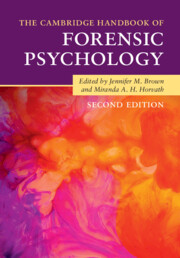Book contents
- The Cambridge Handbook of Forensic Psychology
- The Cambridge Handbook of Forensic Psychology
- Copyright page
- Dedication
- Contents
- Figures
- Tables
- Contributors
- Preface
- Forensic Psychology
- Part I Psychological Underpinnings
- Part II Psychology and Criminal Behaviour
- 2.1 Current Understandings of Sex-Based Harassment and Stalking Perpetration
- 2.2 The Behaviour of Sex Offenders
- 2.3 Intimate Partner Violence
- 2.4 Acquisitive Crime
- 2.5 Terrorism Research
- 2.6 Online Child Sexual Exploitation and Abuse
- 2.7 Arson
- 2.8 Serial Killings and Mass Murder
- Part III Assessment
- Part IV Interventions
- Part V Civil Proceedings
- Part VI Professional Practices
- Index
- References
2.3 - Intimate Partner Violence
from Part II - Psychology and Criminal Behaviour
Published online by Cambridge University Press: 02 December 2021
- The Cambridge Handbook of Forensic Psychology
- The Cambridge Handbook of Forensic Psychology
- Copyright page
- Dedication
- Contents
- Figures
- Tables
- Contributors
- Preface
- Forensic Psychology
- Part I Psychological Underpinnings
- Part II Psychology and Criminal Behaviour
- 2.1 Current Understandings of Sex-Based Harassment and Stalking Perpetration
- 2.2 The Behaviour of Sex Offenders
- 2.3 Intimate Partner Violence
- 2.4 Acquisitive Crime
- 2.5 Terrorism Research
- 2.6 Online Child Sexual Exploitation and Abuse
- 2.7 Arson
- 2.8 Serial Killings and Mass Murder
- Part III Assessment
- Part IV Interventions
- Part V Civil Proceedings
- Part VI Professional Practices
- Index
- References
Summary
This chapter seeks to review the current definitions, laws, thinking and theorising around intimate partner violence, from a UK perspective. The breadth of the behaviours included within this type of offending and the importance and centrality of control within many definitions is highlighted. Differences between 2 key approaches to intimate partner violence or domestic abuse are explored an and the tension between traditional psychological/individually focused approaches and feminist/explanation at a societal/structural level are identified. Heterogeneity across perpetrators and the range of typologies that have been developed to address these differences are described and critiques and issues linked to male victims and female perpetrators and IPV within same sex couples if briefly reviewed.Links between substance use and IPV are considered and a range of models, including the multiple thresholds model, are reviewed. The need for integrated theories is considered. General risk factors for IPV are described and individual risk markers for some perpetrators of IPV are identified.Current commonly used risk assessment tools are described and targets for intervention are briefly explored.
- Type
- Chapter
- Information
- The Cambridge Handbook of Forensic Psychology , pp. 218 - 245Publisher: Cambridge University PressPrint publication year: 2021



